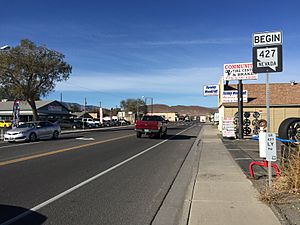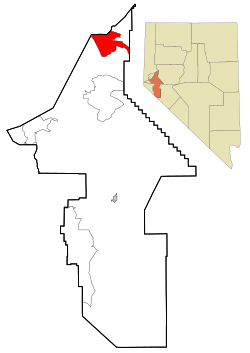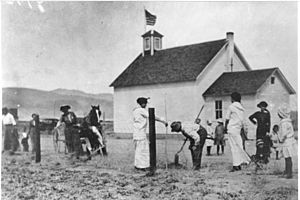Fernley, Nevada facts for kids
Quick facts for kids
Fernley, Nevada
|
||
|---|---|---|

Main Street in Fernley
|
||
|
||
| Motto(s):
"A Great Place to Live, Work, and Play"
|
||

Location of Fernley, Nevada
|
||
| Country | United States | |
| State | Nevada | |
| County | Lyon | |
| Founded | 1904 | |
| Incorporated | July 1, 2001 | |
| Area | ||
| • Total | 128.39 sq mi (332.52 km2) | |
| • Land | 121.65 sq mi (315.07 km2) | |
| • Water | 6.74 sq mi (17.44 km2) | |
| Elevation | 4,636 ft (1,413 m) | |
| Population
(2020)
|
||
| • Total | 22,895 | |
| • Density | 188.20/sq mi (72.67/km2) | |
| Time zone | UTC-8 (PST) | |
| • Summer (DST) | UTC-7 (PDT) | |
| ZIP code |
89408
|
|
| Area code(s) | 775 | |
| FIPS code | 32-24900 | |
| GNIS feature ID | 2410499 | |
Fernley is a city in Lyon County, Nevada, United States. It is part of the larger Reno–Tahoe–Sparks metropolitan area. The city officially became a city in 2001. In 2020, about 22,895 people lived there, making it the 7th largest city in Nevada.
Fernley was once home to one of the first Amazon centers in the world. This center has since moved to another location nearby. Also, the U.S. Navy's famous TOPGUN pilot training program, which teaches advanced air combat, is located close by in Fallon. The city also has the Reno-Fernley Raceway, a place for racing. Not far from Fernley, about 15 miles west, is the world's first Tesla Gigafactory 1. This factory makes battery packs and parts for electric vehicles. A new plant for processing lithium is also being built nearby.
Contents
History of Fernley
Fernley was started in 1904. It grew as a community focused on farming and ranching, close to the city of Reno. No one knows for sure how the name "Fernley" came about. It is one of only two known places in the world with this name.
Much of the farmland in Fernley was developed thanks to the Newlands Irrigation Project. This project, started in 1902, created a system to bring water to farms. It uses water from the Truckee River and sends it to the Lahontan Reservoir near Fallon. The system was built and expanded over many years, until the 1960s. Many of the concrete structures used to control the water still have the stamp of the CCC (Civilian Conservation Corps) and their building date. This irrigation system is managed by the Truckee–Carson Irrigation District.
The Southern Pacific Railroad finished building the Fernley and Lassen Railway in 1914. Later, in the 1920s, the important transcontinental Lincoln Highway was built through the town.
In 1965, the Nevada Cement Company opened a new factory in Fernley. This was the first major business in the area that wasn't about farming or ranching, besides the railroad. Over time, more people in Fernley started working in industry or commuting to jobs in other cities. In the 1970s, some of the old farmlands began to be used for housing subdivisions. This was because many people were moving to the Reno-Sparks area, and Fernley offered more affordable housing and easy access to Interstate 80. New neighborhoods continued to be built, including an 18-hole golf course and a new elementary school.
In 1999, Amazon.com opened a large order fulfillment center in Fernley's industrial park. This brought many new jobs to the city and helped the local economy grow. Since then, other companies like Trex Inc. and Johns Manville have also opened facilities in the area.
On July 1, 2001, Fernley officially became an incorporated city. However, Fernley was hit hard by the Great Recession, a time when the economy struggled.
In 2008, a levee (a wall to prevent flooding) along the Truckee Canal broke. This caused water to flood homes, and about 3,500 people had to be rescued or leave their homes.
Geography and Climate
Fernley is located where several major roads meet: Interstate 80, U.S. Route 50 Alternate, and U.S. Route 95 Alternate. The city covers a total area of about 333.7 square kilometers (128.8 square miles). Most of this area is land, with a smaller part being water.
Climate in Fernley
Fernley has a climate typical of a high desert. Winters can be cold with some snow, but usually not extreme. Summers are generally hot and very dry. Fernley receives about 5 inches (127 mm) of rain each year.
According to the Köppen climate classification, Fernley has a cold desert climate.
| Climate data for Fernley, 1991–2020 simulated normals (4170 ft elevation) | |||||||||||||
|---|---|---|---|---|---|---|---|---|---|---|---|---|---|
| Month | Jan | Feb | Mar | Apr | May | Jun | Jul | Aug | Sep | Oct | Nov | Dec | Year |
| Mean daily maximum °F (°C) | 45.9 (7.7) |
51.1 (10.6) |
58.6 (14.8) |
64.8 (18.2) |
73.8 (23.2) |
84.2 (29.0) |
93.6 (34.2) |
91.9 (33.3) |
83.1 (28.4) |
69.4 (20.8) |
55.6 (13.1) |
45.1 (7.3) |
68.1 (20.1) |
| Daily mean °F (°C) | 34.5 (1.4) |
38.7 (3.7) |
44.8 (7.1) |
50.2 (10.1) |
58.8 (14.9) |
67.8 (19.9) |
76.3 (24.6) |
74.5 (23.6) |
66.0 (18.9) |
53.2 (11.8) |
41.7 (5.4) |
33.6 (0.9) |
53.3 (11.9) |
| Mean daily minimum °F (°C) | 23.4 (−4.8) |
26.2 (−3.2) |
30.9 (−0.6) |
35.6 (2.0) |
44.1 (6.7) |
51.3 (10.7) |
59.0 (15.0) |
57.0 (13.9) |
48.9 (9.4) |
37.0 (2.8) |
28.0 (−2.2) |
22.3 (−5.4) |
38.6 (3.7) |
| Average precipitation inches (mm) | 0.86 (21.96) |
0.63 (15.92) |
0.62 (15.75) |
0.39 (9.86) |
0.65 (16.42) |
0.43 (10.96) |
0.29 (7.49) |
0.17 (4.31) |
0.27 (6.81) |
0.38 (9.76) |
0.43 (11.00) |
0.61 (15.50) |
5.73 (145.74) |
| Average dew point °F (°C) | 23.0 (−5.0) |
23.4 (−4.8) |
24.1 (−4.4) |
24.6 (−4.1) |
29.5 (−1.4) |
32.0 (0.0) |
35.8 (2.1) |
33.8 (1.0) |
30.4 (−0.9) |
27.0 (−2.8) |
23.7 (−4.6) |
22.1 (−5.5) |
27.5 (−2.5) |
| Source: PRISM Climate Group | |||||||||||||
People in Fernley (Demographics)
The population of Fernley has grown quite a bit over the years:
| Historical population | |||
|---|---|---|---|
| Census | Pop. | %± | |
| 1990 | 5,164 | — | |
| 2000 | 8,543 | 65.4% | |
| 2010 | 19,368 | 126.7% | |
| 2020 | 22,895 | 18.2% | |
| U.S. Decennial Census | |||
In 2010, there were 19,368 people living in Fernley. There were about 7,048 households, which are groups of people living together in one home.
Most people in Fernley identified as White (84.5%). Other groups included Black or African American, Native American, Asian, and Pacific Islander people. About 14.4% of the population was Hispanic or Latino.
About 38.7% of households had children under 18 living with them. The average household had 2.74 people. The median age of people in the city was 36.3 years old. This means half the people were younger than 36.3, and half were older.
Education in Fernley
Fernley has its own high school, Fernley High School.
Fernley High School offers many sports programs, clubs, and special learning centers. It also has facilities like a football stadium, baseball field, and a basketball arena. The school has welcomed many international students since the 1990s.
The high school was founded in the late 1950s. Its first buildings were in the old downtown area. Later, it moved to the current Fernley Intermediate School building until 1980. Today, Fernley High is located on the south side of town.
Fernley is also home to a branch of Western Nevada College. This college offers classes for students who want to learn job skills or continue their education after high school.
Places to Visit
Since 1990, Fernley has been home to one of Nevada's two Veterans Memorial Cemeteries. This is the Northern Nevada Veterans Memorial Cemetery, a special place to honor military veterans. The other cemetery is in Boulder City, Nevada.
See also
 In Spanish: Fernley (Nevada) para niños
In Spanish: Fernley (Nevada) para niños



